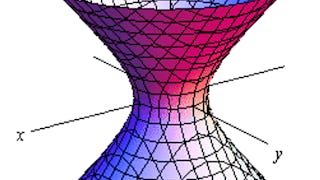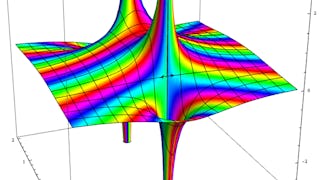This is the third course in the Honors Algebra 2 sequence. By the end of this course, students will be able to analyze, interpret, and apply advanced families of functions, including exponential, logarithmic, radical, and inverse functions. Learners will develop fluency in evaluating and graphing these functions, solving equations that involve them, and applying their properties to real-world models and predictions. Along the way, students will deepen their understanding of how different function types connect, building a stronger algebraic foundation for future courses in precalculus, calculus, and beyond.

要了解的详细信息

添加到您的领英档案
September 2025
16 项作业
了解顶级公司的员工如何掌握热门技能

积累特定领域的专业知识
- 向行业专家学习新概念
- 获得对主题或工具的基础理解
- 通过实践项目培养工作相关技能
- 获得可共享的职业证书

该课程共有4个模块
In earlier courses, you studied polynomials—functions built from whole-number powers of variables. In this module, we expand that perspective to functions with fractional powers, which represent nth roots and can also be written as radical expressions. Our focus will be on building a strong foundation in evaluating radical functions, graphing their behavior, and solving equations that involve them.
涵盖的内容
1个视频4篇阅读材料4个作业
We’ve already practiced creating new functions by translating and stretching the graphs of parent functions. In this module, we’ll explore even more ways to build new functions from existing ones. We'll begin by looking at how two functions can be combined to create a new one. Then, we’ll move on to explore inverse functions. Throughout the rest of the course, we’ll keep using these ideas to understand and work with different types of functions.
涵盖的内容
2个视频2篇阅读材料3个作业
In this module, we explore two new types of functions that arise when modeling natural phenomena: exponential and logarithmic functions. For example, exponential functions are used to represent the growth of a population, the value of an investment, and the elimination of a drug from the body. Logarithmic functions are the inverses of exponential functions. We will start by examining the key features of these functions and their graphs, then look at algebraic rules to transform and solve equations with them. Finally, we will apply exponential and logarithmic functions to build models and make predictions.
涵盖的内容
5个视频4篇阅读材料5个作业
For the last module of this course, we will explore rational functions, which arise naturally when modeling inverse variation. These functions are defined as quotients of polynomials. We will learn about the domain, range, and graphs of rational functions, and practice manipulating them with algebra. Finally, we will see how to solve rational equations.
涵盖的内容
2个视频3篇阅读材料4个作业
获得职业证书
将此证书添加到您的 LinkedIn 个人资料、简历或履历中。在社交媒体和绩效考核中分享。
位教师

从 Math and Logic 浏览更多内容
 状态:免费试用
状态:免费试用Johns Hopkins University
 状态:免费试用
状态:免费试用Johns Hopkins University
 状态:免费试用
状态:免费试用Johns Hopkins University
 状态:免费试用
状态:免费试用Johns Hopkins University
人们为什么选择 Coursera 来帮助自己实现职业发展




常见问题
To access the course materials, assignments and to earn a Certificate, you will need to purchase the Certificate experience when you enroll in a course. You can try a Free Trial instead, or apply for Financial Aid. The course may offer 'Full Course, No Certificate' instead. This option lets you see all course materials, submit required assessments, and get a final grade. This also means that you will not be able to purchase a Certificate experience.
When you enroll in the course, you get access to all of the courses in the Specialization, and you earn a certificate when you complete the work. Your electronic Certificate will be added to your Accomplishments page - from there, you can print your Certificate or add it to your LinkedIn profile.
Yes. In select learning programs, you can apply for financial aid or a scholarship if you can’t afford the enrollment fee. If fin aid or scholarship is available for your learning program selection, you’ll find a link to apply on the description page.
更多问题
提供助学金,



